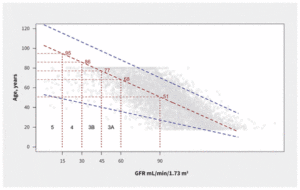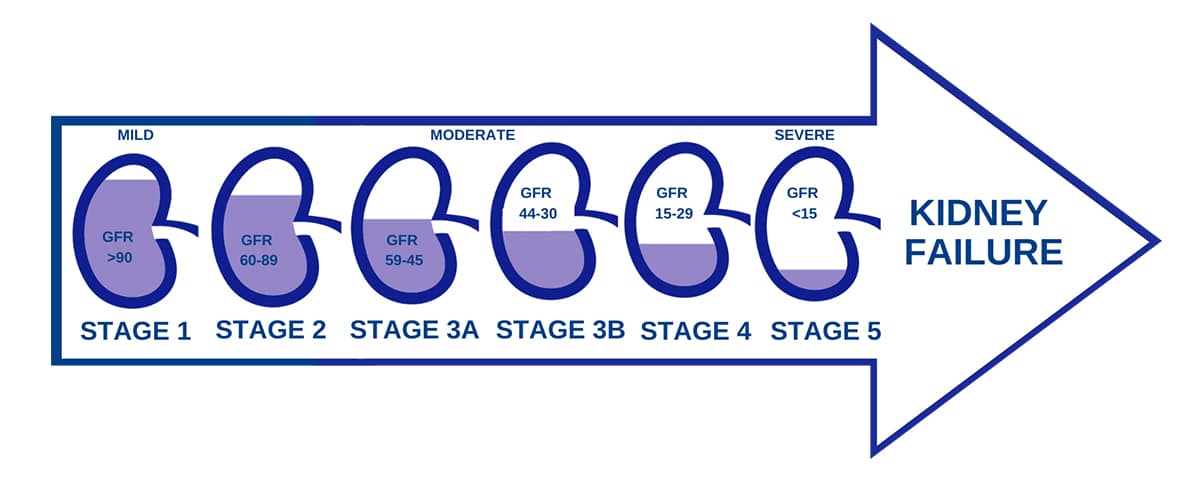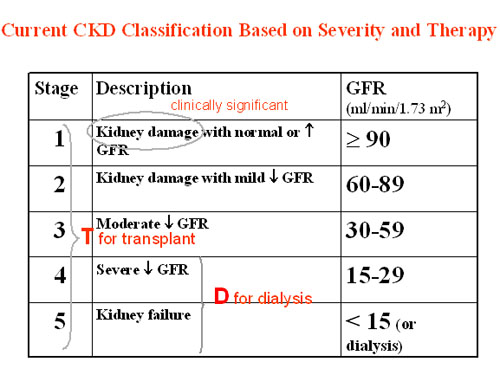CKD. Is it a disease or normal ageing? Does it even exist?
As you can imagine this a deliberately controversial article. Here goes.
Key points
- CKD stages 1 to 4 may be asymptomatic health states. According to previously proposed definitions of disease, they do not meet the criteria to be called a ‘disease’
- Reduced kidney function (currently called CKD) is not abnormal in older age people. In fact it may be abnormal not to have it
- The label ‘chronic kidney disease’ is often misinterpreted by patients and leads to unnecessary anxiety
- Referring to the stages of ‘chronic kidney disease’ as categories of ‘normal kidney age’ could improve patients’ understanding of renal function – and its implications (or not) for health
- Doctors should take greater care in how such information is passed on, e.g. using phrases like ‘normal kidney function for your age’, rather than words like ‘chronic’ and ‘disease’.
We are often told “10% of the population have chronic kidney disease“. This equates to over 7 million people [“CKDEx has fallen into this trap as well, maybe to ‘talk up’ the need for kidney doctors and nurses!” CKDEx Ed].
How can this be true? Do 10% of all humans really have a kidney disease? (no). Is it really more common than 8% of the population that has diabetes (over 5 million people), which we know is a disease? (no). Could it be a computer-generated conclusion (‘diagnosis’), partly based on the patient’s age? (probably).
This concern has led many to question whether CKD is a disease (or exists at all). The question was addressed in a paper called ‘Kidney age, not kidney disease’ (Stevens et al) in 2018. But the debate continues.
CKD/GFR Classification (2002)
Since 2002, the CKD classification (with 5 ‘stages’) (Levey, 2002) has been used by doctors to describe reduced kidney function according to glomerular filtration rate (GFR), or abnormal kidney structure.
GFR is the rate at which blood passes through the 1 million glomeruli (balls of tiny blood vessels called capillaries) in the kidney each minute. It is a marker of one function (of seven functions) of the kidneys (called ‘clearance’, i.e. the ability to clear waste substances) – the higher the GFR, the better the function.
But kidney function (very probably) reduces with age. Thus CKD in older people may not be a disease – just as pregnancy or going bald are not diseases. Like them, loss of kidney function is a normal feature of normal human life at its different stages.
Thus, there is a growing concern amongst kidney doctors that the chosen groupings (‘stages’) are wrong and the concept significantly over-diagnoses reduced kidney function. In fact Stages CKD1-4 may not be diseases at all, just a mathematical construct that is over- and misinterpreted by doctors (who pass on these false beliefs to patients).
This leads to confusion and anxiety for many patients.
GFR and age

This graph shows the relationship between age and GFR (mL/min), from the US’s National Health and Nutrition Examination Survey (2015-2016). It was a huge study of people from all age groups. It shows that there is a normal decline in kidney function with age, that is not (necessarily) a disease.
For this and other reasons, many doctors say GFR naturally falls by about 1 ml/min per year from about the age of 40 – and that is a normal part of ageing and not a disease [“it’s probably not as simple as this”. CKDEx Ed]. Hence someone who has a GFR of 100 ml/min at 40 years, may have a GFR of 59 ml/min at 81 years, and according to the CKD/GFR 5 stage classification, has Stage 3 CKD. They do not. They are normal.
This is another way of looking at it this issue. This chart for average estimated GFR is used by some doctors, based on age.
| Age (years) | Average eGFR |
| 20–29 | 116 |
| 30–39 | 107 |
| 40–49 | 99 |
| 50–59 | 93 |
| 60–69 | 85 |
| 70+ | 75 |
Is this true? Sort of. But the scientific evidence for such tables is not strong.
So what is CKD? Is it a disease?
The short answer is .. we actually don’t know. We don’t even know normal human GFR (it is probably about 120 ml/min in younger people).
So what do we know? Stage 5 CKD (where GFR is below 15 ml/min) clearly should be classified as disease at any age, since the kidneys no longer function, and dialysis or a kidney transplant (or supportive care) is required.
However, after analysing previously published data from the National Health and Nutrition Examination Survey (2015/16), the researchers argued that CKD from Stage 1 to 4 (where GFR declines from 90 to 15 mL/min), does not meet the criteria to be called a ‘disease’. A disease can be defined as an illness with characteristic and consistent causes, symptoms and signs, harms, complications and treatments. CKD1-4 fulfils almost none of these criteria.
Instead they associate CKD1-4 with increasing age, from 51 to 95 years old respectively, since a gradual decline in kidney function is normal in many people in older age groups.
Or, as lead author of the paper, Richard Stevens, an Associate Professor at Oxford University’s Nuffield Department of Primary Care Health Sciences, said,
Communicating a diagnosis of ‘CKD’ to patients can be uncomfortable and unsatisfactory for all concerned, and (doctors) often face an up-hill battle to retrieve the situation with reassurance.
So, what should we say? Describe kidney function as ‘normal kidney ageing’?
Co-author Professor Richard Hobbs, an inner-city Birmingham GP and Head of Oxford University’s Nuffield Department of Primary Care Health Sciences, said that applying the same concepts used by doctors to describe heart or vascular age would likely have greater resonance with patients.
Relabelling CKD stages 1-4 as categories of normal kidney ageing would clear up a common misconception by patients that they require dialysis and transplant due to the use of terms ‘chronic’ and ‘disease’, when their condition is just a normal sign of ageing. For example, a doctor would tell their patient that their kidney age is 68 to 77 years, instead of diagnosing CKD stage 3A.
They would argue that the term ‘chronic kidney disease’ should be reserved for those with later stages: in particular, Stage 5, or symptomatic Stage 4.
Misleading diagrams and tables
The internet is rife with diagrams and tables like below [“and yes they have crept in to CKDEx”, sorry, Ed].
Whilst they may be a fair representation of an invented mathematical construct (and trying to simplify things for patients, which is a good thing), they imply two untrue conclusions:
- All patients with ‘CKD’ (whatever stage) have the same ‘disease’ (that may not be a disease)
- There is a natural (and inevitable) progression (worsening) from Stage 1 to 5 – as shown by following the diagram from left to right, right to left, or top to bottom. Again, this is usually untrue.

Worst still is the type of table below whereby a patient in Stage 3 will think they need a transplant, and someone in Stage 4 will need dialysis imminently. Both may be completely untrue.

These diagrams and tables are not deliberately misleading. But they should be altered to teach the public to see the movement across (or down) as normal for their ageing process.
OK OK. What does CKDEx think?
It’s complicated [“we gathered that!” CKDEx Ed].
Stages CKD1-4 are useful mathematical constructs, and useful for monitoring patients. Although often not a disease themselves, they can be a sign that a patient is at risk of CKD5 (i.e. they are risk factors).
But doctors should take greater care in how such information is passed on, using phrases like ‘normal kidney function for your age’, rather than words like ‘chronic’ and ‘disease’.
Doctors need to be more careful in how they describe CKD to patients, especially the elderly.
Note. CKDEx would stress that chronic kidney disease remains a significant health concern for some and the concept (and term) ‘kidney age’ should only apply to age-related kidney decline. Conditions affecting the kidney such as nephrotic syndrome and CKD5 (say due to polycystic disease or chronic glomerulonephritis) clearly are diseases and do exist. They fall outside the scope of a definition of kidney ageing.
Summary
The question of whether CKD is a disease (or not), or part of normal ageing, has been debated. Some think that CKD is not just a ‘non-disease’, but actually does not exist. They think, at worst it is a mathematical construct; at best, a risk factor for (true) kidney failure (CKD5). Either way, poor use of medical language can lead to unnecessary anxiety, especially in the elderly.
Other resources
The KDOQI 2002 classification of chronic kidney disease: for whom the bell tolls (Hallan, 2010)
Kidney age, not kidney disease (Stevens, 2018)
Accounting for Age in the Definition of Chronic Kidney Disease (Liu, 2021). This is an interesting paper (on a very large number of people) that is worth reading. Its main conclusion is that a GFR of 45 to 59 mL/min (i.e. ‘CKD3A’) without albuminuria, in elderly individuals, may have limited meaning (other than they are older). It may deserve recognition, and encourage treatment of modifiable risk factors for death (e.g. BP); but has no implication for kidney outcomes.
What should GFR be at age 70 years?
GFR meaning and limitations
What is normal GFR?
Last Reviewed on 26 April 2024
